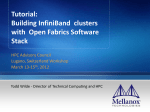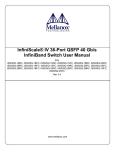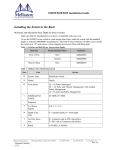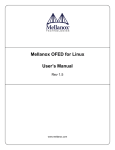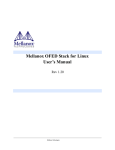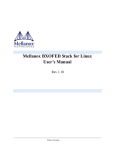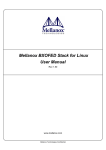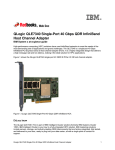Download Mellanox InfiniBand Training
Transcript
InfiniBand For HPC Overview
HPC Advisory Council
Switzerland Workshop
March 21-23, 2011
Erez Cohen - Sr. Director of Field Engineering
InfiniBand Overview
© 2011 MELLANOX TECHNOLOGIES
- MELLANOX CONFIDENTIAL -
2
The InfiniBand Architecture
Industry standard defined by the InfiniBand Trade
Association
Defines System Area Network architecture
• Comprehensive specification:
from physical to applications
Rev
1.0
2000
Rev
1.0a
2001
Rev
1.1
2002
Rev
1.2
…
2004
Processor
Node
Rev
1.2.1
…
2007
HCA
Consoles
Architecture supports
•
•
•
•
HCA
Subnet
Manager
Switch
HCA
Switch
TCA
TCA
Gateway
Gateway
Fibre
Channel
RAID
Storage
Subsystem
- MELLANOX CONFIDENTIAL -
Processor
Node
Switch
Switch
• Low latency / high bandwidth
• Transport offload
3© 2011 MELLANOX TECHNOLOGIES
InfiniBand
Subnet
HCA
Host Channel Adapters (HCA)
Target Channel Adapters (TCA)
Switches
Routers
Facilitated HW design for
Processor
Node
Ethernet
3
InfiniBand Feature Highlights
Serial High Bandwidth Links
Quality Of Service
• 56 Gb/s HCA links
• Up to 120Gb/s switch-switch links
Ultra low latency
• Under 1 us application to application
Reliable, lossless, self-managing
fabric
• Link level flow control
• Congestion control to prevent HOL
blocking
• Independent I/O channels at the adapter
level
• Virtual Lanes at the link level
Cluster Scalability/flexibility
• Up to 48K nodes in subnet, up to 2128 in
network
• Parallel routes between end nodes
• Multiple cluster topologies possible
Simplified Cluster Management
Full CPU Offload
• Hardware Based Transport Protocol
• Reliable Transport
• Kernel Bypass (User level applications
get direct access to hardware)
• Centralized route manager
• In-band diagnostics and upgrades
Memory exposed to remote node
access
• RDMA-read and RDMA-write
© 2011 MELLANOX TECHNOLOGIES
- MELLANOX CONFIDENTIAL -
4
InfiniBand Components
Host Channel Adapter
(HCA)
• Device that terminates an IB
link and executes transportlevel functions and support the
verbs interface
Switch
• A device that routes packets
from one link to another of the
same IB Subnet
Router
• A device that transports
packets between IBA subnets
© 2011 MELLANOX TECHNOLOGIES
- MELLANOX CONFIDENTIAL -
5
IB Architecture Layers
• Physical
- Signal levels and Frequency; Media; Connectors
• Link
- Symbols and framing; Flow control (credit-based); How packets are
routed from Source to Destination
• Network
- How packets are routed between subnets
• Transport
- Delivers packets to the appropriate Queue Pair; Message
Assembly/De-assembly, access rights, etc.
• Software Transport Verbs and Upper Layer Protocols
- Interface between application programs and hardware.
- Allows support of legacy protocols such as TCP/IP
- Defines methodology for management functions
© 2011 MELLANOX TECHNOLOGIES
- MELLANOX CONFIDENTIAL -
6
InfiniBand Layered Architecture
© 2011 MELLANOX TECHNOLOGIES
- MELLANOX CONFIDENTIAL -
7
Physical Layer – Link Rate
InfiniBand uses serial stream of bits for data transfer
Link width
• 1x – One differential pair per Tx/Rx
- Not used today
• 4x – Four differential pairs per Tx/Rx
- Used on all Mellanox HCA, switch and cables
• 12x - Twelve differential pairs per Tx and per Rx
- Limited use
Link Speed
•
•
•
•
•
Single Data Rate (SDR) – 2.5 Gb/s signaling (10-Gb/s for 4x)
Double Data Rate (DDR) – 5 Gb/s signaling (20-Gb/s for 4x)
Quad Data Rate (QDR) - 10 Gb/s signaling (40-Gb/s for 4x)
FDR - 14Gb/s signaling (56-Gb/s for 4x). 64/66 Encoding
EDR (25-Gb/lane) coming in near future
Link rate
• Multiplication of the link width and link speed
• Most common shipping today is 4x QDR (40Gb/s)
© 2011 MELLANOX TECHNOLOGIES
- MELLANOX CONFIDENTIAL -
8
Physical Layer Cont’
Media types
•
•
•
•
PCB: several inches
Copper: 20m SDR, 10m DDR, 7m QDR
Fiber: 300m SDR, 150m DDR, 100/300m QDR
CAT6 Twisted Pair in future.
8 to 10 bit encoding for SDR, DDR and QDR
64/66 bit encoding for FDR
Industry standard components
• Copper cables / Connectors
• Optical cables
• Backplane connectors
4X QSFP
4x QSFP Fiber
FR4 PCB
12X Cable
© 2011 MELLANOX TECHNOLOGIES
4x CX4 Fiber
4X CX4
- MELLANOX CONFIDENTIAL -
9
Cable Interconnect
microGiGaCN
CX4
QSA
QSFP
© 2011 MELLANOX TECHNOLOGIES
- MELLANOX CONFIDENTIAL -
SFP+
10
Link Layer: Packets
Packets are routable end-to-end fabric unit of transfer
• Link management packets: train and maintain link operation
• Data packets
-
Send
Read
Write
Acks
© 2011 MELLANOX TECHNOLOGIES
- MELLANOX CONFIDENTIAL -
11
Link Layer: Payload Size
Maximum Transfer Unit (MTU)
• MTU allowed from 256 Bytes to 4K Bytes (Message sizes much
larger).
• Only packets smaller than or equal to the MTU are transmitted
• Large MTU is more efficient (less overhead)
• Small MTU gives less jitter
• Small MTU preferable since segmentation/reassembly performed
by hardware in the HCA.
• Routing between end nodes utilizes the smallest MTU of any link
in the path (Path MTU)
© 2011 MELLANOX TECHNOLOGIES
- MELLANOX CONFIDENTIAL -
12
Link Layer: Virtual Lanes (Quality of Service)
16 Service Levels (SLs)
• A field in the Local Routing Header (LRH) of an InfiniBand packet
• Defines the requested QoS
Virtual Lanes (VLs)
• A mechanism for creating multiple channels within a single physical link.
• Each VL:
- Is associated with a set of Tx/Rx buffers in a port
- Has separate flow-control
• A configurable Arbiter control the Tx priority of each VL
• Each SL is mapped to a VL
• IB Spec allows a total of 16 VLs (15 for Data & 1 for Management)
- Minimum of 1 Data and 1 Management required on all links
- Switch ports and HCAs may each support a different number of VLs
• VL 15 is a management VL and is not a subject for flow control
© 2011 MELLANOX TECHNOLOGIES
- MELLANOX CONFIDENTIAL -
13
Link Layer: Flow Control
Credit-based link-level flow control
• Link Flow control assures NO packet loss within fabric even in the presence of
congestion
• Link Receivers grant packet receive buffer space credits per Virtual Lane
• Flow control credits are issued in 64 byte units
Separate flow control per Virtual Lanes provides:
• Alleviation of head-of-line blocking
• Virtual Fabrics – Congestion and latency on one VL does not impact traffic with
guaranteed QOS on another VL even though they share the same physical link
Link
Control
Arbitration
Packets
Mux
© 2011 MELLANOX TECHNOLOGIES
Link
Control
Credits
Returned
Packets
Transmitte
d
Demux
- MELLANOX CONFIDENTIAL -
Receive
Buffers
14
Link Layer: Addressing
Local ID (LID)
• 16 bit field in the Local Routing Header (LRH) of all IB packets
• Used to rout packet in an InfiniBand subnet
• Each subnet may contain up to:
- 48K unicast addresses
- 16K multicast addresses
Assigned by Subnet Manager at initialization and topology changes
© 2011 MELLANOX TECHNOLOGIES
- MELLANOX CONFIDENTIAL -
15
Layer 2 Forwarding
Switches use FDB (Forwarding Database)
• Based on DLID and SL a packet is sent to the correct output port.
Multicast Destinations supported!!
SL
DLID
Payload
Switch
Outbound Packet
FDB
(DLID to Port)
Port
Port
Port
Port
Port
SL to VL
Table
Port
Inbound Packet
Port
Port
© 2011 MELLANOX TECHNOLOGIES
- MELLANOX CONFIDENTIAL -
16
Network Layer
Responsibility
• The network layer describes the protocol for routing a packet between subnets
Globally Unique ID (GUID)
• A 64 bit field in the Global Routing Header (GRH) used to route packets between
different IB subnets
• Every node must have a GUID
• IPv6 type header
© 2011 MELLANOX TECHNOLOGIES
- MELLANOX CONFIDENTIAL -
17
Transport Layer: Queue Pairs
•QPs are in pairs (Send/Receive)
•Work Queue is the consumer/producer interface to the fabric
•The Consumer/producer initiates a Work Queue Element (WQE)
•The Channel Adapter executes the work request
•The Channel Adapter notifies on completion or errors by writing a
Completion Queue Element (CQE) to a Completion Queue (CQ)
© 2011 MELLANOX TECHNOLOGIES
- MELLANOX CONFIDENTIAL -
18
Transport Layer: Types Transfer Operations
SEND
• Read message from HCA local system memory
• Transfers data to Responder HCA Receive Queue logic
• Does not specify where the data will be written in remote memory
• Immediate Data option available
RDMA Read
• Responder HCA reads its local memory and returns it to the Requesting
HCA
• Requires remote memory access rights, memory start address, and
message length
RDMA Write
• Requester HCA sends data to be written into the Responder HCA’s
system memory
• Requires remote memory access rights, memory start address, and
message length
© 2011 MELLANOX TECHNOLOGIES
- MELLANOX CONFIDENTIAL -
19
Transport Services
snd
rcv
snd
rcv
snd
rcv
snd
rcv
snd
rcv
QP
QP
QP
QP
snd
rcv
snd
rcv
snd
rcv
snd
rcv
QP
QP
QP
© 2011 MELLANOX TECHNOLOGIES
QP
UC
- MELLANOX CONFIDENTIAL -
CQ
Non-connected
snd
rcv
QP
snd
rcv
Connected
snd
rcv
QP
UD
cqe
cmd
snd
rcv
cqe
cmd
CQ
QP
rcv
snd
QP
QP
snd
rcv
cqe
cmd
CQ
QP
rcv
snd
cqe
cmd
Reliable
QP
CQ
QP
Unreliable
RD
XRC
RC
20
Verbs
Verbs are the SW interface to the HCA and the IB fabric
Verbs are not API but rather allow flexibility in the API
implementation while defining the framework
Some verbs for example
•
•
•
•
•
Open/Query/Close HCA
Create Queue Pair
Query Completion Queue
Post send Request
Post Receive Request
Upper Layer Protocols (ULPs) are application writing over the
verbs interface that bridge between standard interfaces like TCP/IP
to IB to allow running legacy application intact
© 2011 MELLANOX TECHNOLOGIES
- MELLANOX CONFIDENTIAL -
21
Management Model
SNMP Tunneling Agent
Application-Specific Agent
Vendor-Specific Agent
Device Management Agent
Performance Management Agent
Communication Mgmt (Mgr/Agent)
Baseboard Management Agent
Subnet Administration (an Agent)
General Service Interface
QP1 (virtualized per port)
Uses any VL except 15
MADs called GMPs - LID-Routed
Subject to Flow Control
© 2011 MELLANOX TECHNOLOGIES
Subnet Manager (SM) Agent
Subnet Manager
Subnet Management Interface
QP0 (virtualized per port)
Always uses VL15
MADs called SMPs – LID or Direct-Routed
No Flow Control
- MELLANOX CONFIDENTIAL -
22
Subnet Management
Topology Discovery
FDB Initialization
Fabric Maintenance
LID Route
Initialization uses
Directed Route MADs:
System
Memory
Each Subnet must have a
Subnet Manager (SM)
Subnet
Manager
Standby
Standby
Subnet
Manager
SM
CPU
IB
Switch
HCA
SMA
IB
Switch
SMA
IB
Switch
SMA
HCA
SMA
© 2011 MELLANOX TECHNOLOGIES
HCA
Every entity (CA, SW, Router)
must support a Subnet
Management Agent (SMA)
SMA
SMA
MADs use unreliable
datagrams
SMA
IB
Switch
HCA
LID Route
TCA
SMA
HCA
Directed Route Vector
Multipathing: LMC Supports
LMC: 1 Multiple LIDS
LID = 6,7
- MELLANOX CONFIDENTIAL -
23
InfiniBand Cluster Topologies
© 2011 MELLANOX TECHNOLOGIES
- MELLANOX CONFIDENTIAL -
24
Cluster Topologies
Two topologies are mainly in use for large clusters
• Fat-Tree (most popular topology in HPC)
• 3D Torus
Fat-tree characteristics:
• Use same BW for all links (or close BW)
• Many times use same number of ports for all switches
• Many configurations are possible
• But they are all only “Rearrangeably Non Blocking”
- For any permutation of src/dst pairs exists non-blocking routing
Main issues with fabric design
• Is the SM capable of routing the fabric?
• Does it generate credit loops?
• Are the paths evenly distributed?
© 2011 MELLANOX TECHNOLOGIES
- MELLANOX CONFIDENTIAL -
25
324 Node Full FAT Tree using MTS5030 (max 648 ports)
L2-1
Shark-GT
STATUS
PSU 1
PSU 2
FAN
IS5030
MGT CONSOLE
STATUS
PSU 1
PSU 2
FAN
RST
RST
L1-1
L1-2
IS5030
MGT CONSOLE
STATUS
PSU 1
PSU 2
FAN
L2-9
IS5030
MGT CONSOLE
RST
L1-18
IS5030
MGT CONSOLE
STATUS
PSU 1
PSU 2
FAN
RST
IS5030
MGT CONSOLE
STATUS
PSU 1
PSU 2
FAN
RST
Shark-GT
18 Links
To Compute Nodes
18 Links
To Compute Nodes
2 x 4X QDR Uplinks
1 x 4X QDR Uplinks
© 2011 MELLANOX TECHNOLOGIES
- MELLANOX CONFIDENTIAL -
26
InfiniBand Linux
SW Stack
MLNX_OFED
© 2011 MELLANOX TECHNOLOGIES
- MELLANOX CONFIDENTIAL -
27
OpenFabrics Enterprise Distribution (OFED)
Open Fabrics Enterprise Distribution (OFED) is a complete
SW stack for RDMA capable devices.
Contains low level drivers, core, Upper Layer Protocols
(ULPs), Tools and documents
Available on OpenFabrics.org or as a Mellanox supported
package at:
• http://www.mellanox.com/content/pages.php?pg=products_dyn&product
_family=26&menu_section=34
Mellanox OFED is a single Virtual Protocol Interconnect (VPI)
software stack based on the OFED stack
• Operates across all Mellanox network adapters
• Supports:
-
SDR, DDR, QDR and FDR InfiniBand
10Gb/s Ethernet (10GigE)
Fiber Channel over Ethernet (FCoE)
2.5 or 5.0 GT/s PCI Express 2.0
© 2011 MELLANOX TECHNOLOGIES
- MELLANOX CONFIDENTIAL -
28
The SW stack
© 2011 MELLANOX TECHNOLOGIES
- MELLANOX CONFIDENTIAL -
29
MLNX_OFED Installation
Pre-built RPM install.
• 1. mount -o rw,loop MLNX_OFED_LINUX-*.iso /mnt
• 2. cd /mnt
• 3. ./mlnxofedinstall
Building RPMs for un-supported kernels.
•
•
•
•
•
•
•
1. mount -o rw,loop MLNX_OFED_LINUX-*.iso /mnt
2. cd /mnt/src
3. cp OFED-*.tgz /root (this is the original OFED distribution tarball)
4. tar zxvf OFED-*.tgz
5. cd OFED-*
6. copy ofed.conf to OFED-* directory
7. ./install.pl -c ofed.conf
© 2011 MELLANOX TECHNOLOGIES
- MELLANOX CONFIDENTIAL -
30
30
OpenSM - Features
OpenSM (osm) is an InfiniBand compliant subnet manger.
Included in Linux Open Fabrics Enterprise Distribution.
Ability to run several instance of osm on the cluster in a
Master/Slave(s) configuration for redundancy.
Partitions (p-key) support
QoS support
Congestion Control
Adaptive Routing
Enhanced routing algorithms:
•
•
•
•
•
Min-hop
Up-down
Fat-tree
LASH
DOR
© 2011 MELLANOX TECHNOLOGIES
- MELLANOX CONFIDENTIAL -
31
31
Running OpenSm
Command line
• Default (no parameters)
Scans and initializes the IB fabric and will occasionally sweep for changes
E.g. to start with up-down routing: opensm –-routing_engine updn
• opensm –h for usage flags
• Run is logged to two files:
- /var/log/messages – opensm messages, registers only general major events
- /var/log/opensm.log - details of reported errors.
Start on Boot
• As a daemon:
- /etc/init.d/opensmd start|stop|restart|status
- /etc/opensm.conf for default parameters
# ONBOOT
# To start OpenSM automatically set ONBOOT=yes
ONBOOT=yes
SM detection
• /etc/init.d/opensd status
- Shows opensm runtime status on a machine
• sminfo
- Shows master and standby subnets running on the cluster
© 2011 MELLANOX TECHNOLOGIES
- MELLANOX CONFIDENTIAL -
32
32
IPoIB in a Nut Shell
Encapsulation of IP packets over IB
Uses IB as “layer two” for IP
• Supports both UD service (up to 2KB MTU) and RC service (connected mode,
up to 64KB MTU).
IPv4, IPv6, ARP and DHCP support
Multicast support
VLANs support
Benefits:
• Transparency to the legacy applications
• Allows leveraging of existing management infrastructure
Specification state: IETF Draft
© 2011 MELLANOX TECHNOLOGIES
- MELLANOX CONFIDENTIAL -
33
33
IPoIB in Generic Protocol Stack
Application
user
Socket Library
kernel
Protocol Switch
TCP
network
device
interface
UDP
…
ICMP
IP
IPoIB
Verbs
Access Layer
Ethernet
NIC Driver
HW
© 2011 MELLANOX TECHNOLOGIES
- MELLANOX CONFIDENTIAL -
34
34
MPI
A message passing interface
Used for point to point communication
• MPI_I/SEND, MPI_I/RECV
Used for collective operations:
• MPI_AlltoAll, MPI_Reduce, MPI_barrier
Other primitives
• MPI_Wait, MPI_Walltime
MPI Ranks are IDs assigned to each process
MPI Communication Groups are subdivisions a job node
used for collectives
Three MPI stacks are included in this release of OFED:
• MVAPICH 1.1.0
• Open MPI 1.2.8
This presentation will concentrate on MVAPICH-1.1.0
© 2011 MELLANOX TECHNOLOGIES
- MELLANOX CONFIDENTIAL -
35
35
MPI Example
01:
MPI_Init(&argc,&argv);
02:
MPI_Comm_size(MPI_COMM_WORLD,&numprocs);
03:
MPI_Comm_rank(MPI_COMM_WORLD,&myid);
04:
05:
MPI_Barrier(MPI_COMM_WORLD);
06:
07:
if(myid==0)
08:
printf("Passed first barrier\n");
09:
10:
srand(myid*1234);
11:
x = rand();
12:
13:
printf("I'm rank %d and my x is 0x%08x\n",myid, x);
14:
15:
MPI_Barrier(MPI_COMM_WORLD);
16:
17:
MPI_Bcast(&x,1,MPI_INT,0,MPI_COMM_WORLD);
18:
19:
if(myid == 1)
20:
printf("My id is rank 1 and I got 0x%08x from rank 0\n", x);
21:
22:
if(myid == 2)
23:
printf("My id is rank 2 and I got 0x%08x from rank 1\n", x);
24;
25:
MPI_Finalize();
© 2011 MELLANOX TECHNOLOGIES
- MELLANOX CONFIDENTIAL -
36
36
Compiling
mpicc is used to compiling mpi applications
mpicc is equivalent to gcc
mpicc includes all the gcc flags needed for compilation
• Head files paths
• Libraries paths
To see real compilation flag run: mpicc –v
MPI application can be shared or dynamic
© 2011 MELLANOX TECHNOLOGIES
- MELLANOX CONFIDENTIAL -
37
37
Launching MPI jobs using mpirun_rsh
Prerequisites for Running MPI:
• The mpirun_rsh launcher program requires automatic login (i.e.,
password-less) onto the remote machines.
• Must also have an /etc/hosts file to specify the IP addresses of all
machines that MPI jobs will run on.
• Make sure there is no loopback node specified (i.e. 127.0.0.1) in the
/etc/hosts file or jobs may not launch properly.
• Details on this procedure can be found in Mellanox OFED User’s manual
Basic format:
• mpirun_rsh –np procs node1 node2 node3 BINARY
Other flags:
-show: show only
-paramfile: environment variables
-hostfile: list of host
-ENV=VAL (i.e. VIADEV_RENDEZVOUS_THRESHOLD=8000)
© 2011 MELLANOX TECHNOLOGIES
- MELLANOX CONFIDENTIAL -
38
38
Hands On
© 2011 MELLANOX TECHNOLOGIES
- MELLANOX CONFIDENTIAL -
39
InfiniBand For HPC – Hands On
Set up
• 2 servers with ConnectX HCA running SLES 11
• 8 port QDR IB switch based on InfiniScale 4 switch silicon
Steps
•
•
•
•
•
•
•
•
Identify OFED package
Install OFED package
Configure IPoIB interface
Run OpenSM
Check HCA status
Test IPoIB (ping)
Run MPI test without IB
Run BW and Latency tests over IB
© 2011 MELLANOX TECHNOLOGIES
- MELLANOX CONFIDENTIAL -
40
Thank You
www.mellanox.com
© 2011
41MELLANOX TECHNOLOGIES
- MELLANOX CONFIDENTIAL -
41









































